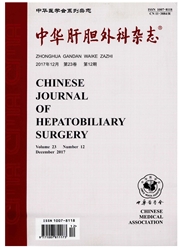

 中文摘要:
中文摘要:
目的研究不同肝脏血流阻断技术对术中吲哚青绿滞留试验的影响。方法回顾性分析我院2009—2010年62例接受肝部分切除治疗肝癌患者的临床资料。其中A组13例术中未行肝门阻断;B组29例术中行第一肝门阻断(Pringle法);C组20例术中行选择性入肝血流(肝动脉、门静脉)阻断。术前及术中均行分光脉动法吲哚青绿滞留试验。结果(1)与A组比较,B组、C组术中出血量减少,差异有统计学意义(P=0.016,P=0.001)。(2)三组患者术前吲哚青绿15min滞留率(ICGR15)无明显差异,B组术中ICGRl5明显高于A、C组(P=0.011,P=0.030)。(3)三组患者术中ICGR15均较术前有所升高,其幅度与术中出血量(r=0.349,P=0.005)及第一肝门阻断总时间(r=0.484,P=0.001)有明显的相关性。(4)C组患者术后肝脏功能恢复情况优于A、B组患者。结论选择性人肝血流阻断技术既可以减少肝切除术中缺氧损伤又可以避免缺血再灌注损伤,有利于患者的术后康复,特别适用于合并肝硬化的患者。
 英文摘要:
英文摘要:
Objective To investigate the impact of different hepatic vascular inflow occlusion methods on hepatic parenchymal function in partial hepatectomy. Methods Between 2009 and 2010, 62 hepatocellular carcinoma (HCC) patients underwent partial hepatectomy. In 13 patients, partial hepatectomy was carried out without using any inflow occlusion (group A). In 29 patients intermittent Pringle's maneuver (group B) while in 20 patients selective hepatic inflow occlusion (group C) were used. Intraoperative indocyanine green retention rate at 15 minutes (ICGR15) was measured using pulse spectrophotometry before and during hepatectomy. Results (1) Blood loss in group A was greater than group B and C (P=0. 016, P=0. 001). (2) There was no significant difference in the preoperative ICGR15 values among group A, B and C. The intraoperative ICGR15 for group B was significantly higher than group A and C (P=0. 011, P=0. 030). (3) A significant correlation was found between the level of ICGR15 and total inflow clamp time (r= 0. 484, P= 0. 001) and blood loss (r=0. 349, P=0. 005), respectively. (4) Compared with group A and B, postoperative liver function recovered significantly faster in group C. Conclusion Selective hepatic inflow occlusion was useful in controlling blood loss and it was beneficial to the hepatic functional reserve in the liver remnant.
 同期刊论文项目
同期刊论文项目
 同项目期刊论文
同项目期刊论文
 期刊信息
期刊信息
